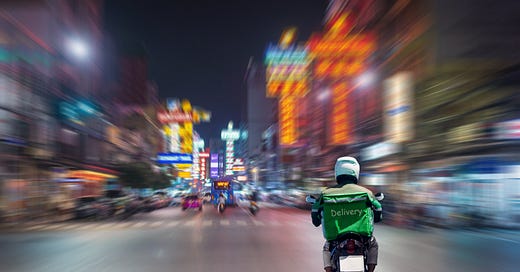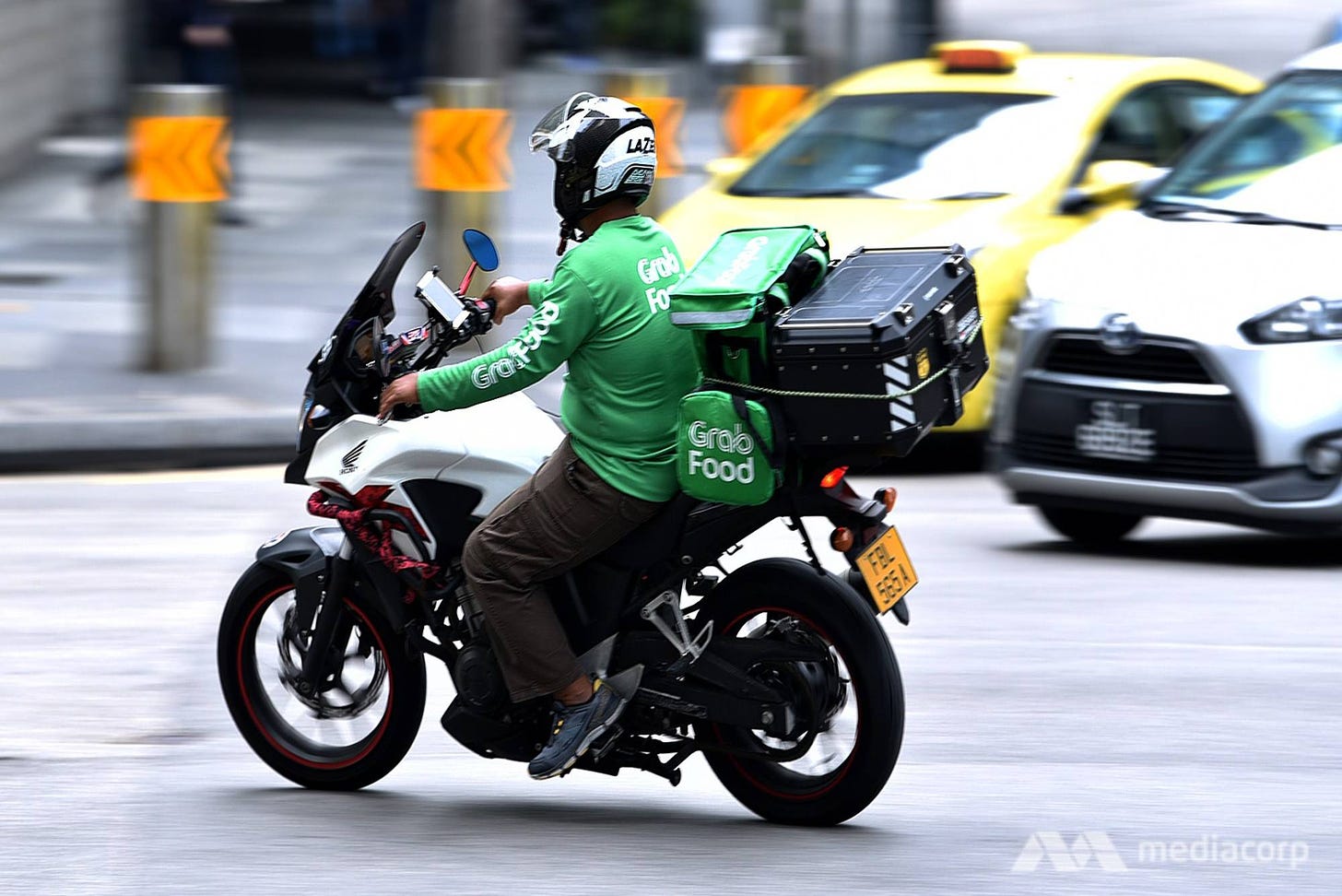Why the Motorbike Delivery Driver is a Symbol of Our Times
Motorbike riders serve as vital arteries of the global food delivery industry, especially in the emerging world. Are they being exploited in our insta-demand economy?
Jet-lagged from a long flight that landed in the middle of the night, I woke up the next morning to the familiar sound of motorbikes. I was in Tehran, early 2000s, but this could have been any number of populous Asian cities. That buzzing motor sound has become the background music of the urban emerging world.
That sound has also become a symbol of our instant gratification, insta-demand economy, often associated with the Western world, but very much alive and growing in the emerging world. From Santiago to Singapore, from Johannesburg to Jakarta, from Brasilia to Beijing, the motorbike driver weaving through traffic in a colorful, branded uniform with a parcel of food attached to the back of the bike, has become an ubiquitous site - and that buzzing sound ever more present.
They work for Uber Eats or India-based Zomato or Beijing-based Meituan or Singapore-based Grab or one of dozens of other regional or global start-ups with catchy names and snappy logos that provide food delivery on demand to a rising middle class. Many of these tech platforms have grown fabulously rich and several more will join their ranks as they prepare initial public offerings.
Southeast Asia’s superapp, Grab, recently went public in the US via a Special Purpose Acquisition Vehicle (SPAC) with a $40 Billion value. It was the largest SPAC deal to date and captured headlines and attention worldwide. China’s publicly-listed Meituan has a market cap north of $190 billion. India-based Zomato recently got an infusion of cash from global investors, bringing its market valuation to $5.4 Billion. Uber Eats generated nearly $5 billion in revenue in 2020 and operates in some 50 countries worldwide.
Consumers have developed a taste for real-time, on-demand ordering of everything from car rides to groceries to food and beyond. The global food delivery service is big business, clocking in at roughly $110 billion today, and rapidly growing toward $254 billion by 2028.
No doubt, we are living in a food delivery renaissance that has opened up a world of convenience and choice to the consumer and has benefited restaurant and food businesses - as well as many of the side-hustle delivery workers who can supplement their incomes through delivery.
But that upside also has a downside, and one place to look is the backbone of the food delivery service in the emerging world: the motorbike driver. Troubling questions mount about the human cost to overworked, often underpaid, and uninsured delivery drivers hurtling onward to the next delivery, the next milestone, the next bonus, simply to eke out a living.
The motorbike delivery person might be an apt symbol for our times. They rush through growing urban centers atop a motorbike, linked by smartphones and unprecedented connectivity, delivering food for a rising middle class, while algorithms track their movements to maximize future efficiency, and ever more powerful tech platforms benefit from these Uber-ized gig workers.
The food delivery industry in China may have had its Mohammed Bouazizi moment a few months ago. Bouazizi, as you will recall, was the Tunisian fruit and vegetable vendor that doused himself in gasoline and lit himself on fire to protest the confiscation of his work permit amid an environment of predatory police and state corruption. That act of self-immolation sparked the Tunisian uprising that spread across the Arab world. When he protested the move and lit himself on fire, he cried out simply: “How am I supposed to make a living?”
In January, as the remarkable site Rest of World, reported, “a worker at Ele.me, a Chinese food delivery platform, doused himself in gasoline and set himself on fire in the eastern city of Taizhou to protest withheld earnings.” Rest of World’s Yi-Ling Liu reported that “the company had refused to give him his pay, around $700 (5,000 yuan), after he attempted to switch to another platform. Covered in ash and third-degree burns, the man was filmed yelling, ‘I want my blood-and-sweat money,’ as bystanders tried to extinguish the flames.”
From “how am I supposed to make a living?” a decade ago in Sidi Bouzid Tunisia to "I want my blood-and-sweat money,” in Taizhou, China this year, a familiar theme emerges: workers in the informal or gig economy are on edge, scraping by to make a living, frustrated and anguished, whipsawed by powerful tech and globalization currents of which they have little or no control.
A Thomson Reuters Foundation report notes that underage workers on bicycles have been found working on delivery apps in Brazil. Reuters also reports a spike in sometimes deadly accidents of motorbike delivery drivers in South Africa, who are often migrants from other African countries, with little or no access to local health care and no coverage or compensation by the tech platforms. China’s fiercely competitive battles between the two biggest food delivery players - Meituan and Ele.me - has sparked a race to the bottom on pay and benefits for drivers while relentlessly slashing prices for consumers.
Again, the story by Yi Ling-Liu in Rest of World is worth a close read. She notes a growing and “widespread backlash against the country’s app-based delivery industry.” She writes:
“A viral investigation published last fall in Renwu magazine exposed shocking details about its inner workings: how algorithms set unrealistic expectations, the ease with which drivers can be fired, and the frequency of casualties and gory injuries. In response to public fury on social media, Meituan and Ele.me announced new policies — they would give drivers an extra five to 10 minutes to make their deliveries. But they failed to address the deep-seated, structural problems that enable this kind of exploitation: namely, toxic work cultures that maximize competition and the use of increasingly sophisticated algorithms that track, monitor, and govern the lives of employees.”
A recent report by Friedrich Ebert Stiftung Foundation found at least 500 cases of reported labor unrest among food delivery workers worldwide within the last three years, including Europe and the United States. They counted nineteen major food delivery players operating in 95 countries worldwide, with Uber Eats the most global.
The report notes that the most frequently cited complaint among drivers was the rate of pay, followed by employment status, working conditions, and health and safety regulations. “Our findings suggest a remarkable amount of labor unrest involving workers on food delivery platforms.” the report’s authors conclude.
Another academic study looked at motorbike food delivery couriers in Sao Paolo. One of the drivers felt as if the company was “gaming” him. He said:
“On rainy days such as this morning, they send me a message at 9 a.m.: ‘if you deliver eight orders between 10 a.m. and 1 p.m., you get an extra R$ 50’. If not, you won’t get a bonus (...). Me, you and another motorbike courier are working there, we need to deliver eight orders each to get the bonus. You and I have already done seven and the other courier has done four. Who will they give the next orders to? To the other guy.”1
Of course, there are plenty of cases where the delivery drivers are pleased. As Reuters reports on South Korea’s rising tide of food delivery, it quoted Chey Young-ah, a 37-year-old former art teacher who turned to delivery during class shut-downs. “I feel lucky I found this field at a time when deliveries are booming,” she told Reuters. “One of the merits of this job is that the entry barrier is low. They don’t care whether you’re a man or a woman, you don’t need a job interview.”
When food delivery becomes a side gig or a transitional option or even a retirement job, that’s when the system seems to work for all sides. But for many of the motorbike riders in the emerging world, they don’t have the luxury of treating the job as a “side hustle” to earn some extra income. It’s their day - and increasingly night — job, not just a gig.
And they are often left to their own devices. For them, the gig economy is not as liberating as it can be for others. For them, it’s the “gig-enstein” economy that has left them on the eternal treadmill, atop a motorbike, weaving in and out of traffic, lonely and hurried and tracked by an algorithm, wondering if they will make enough to meet their weekly expenses, hoping for some deliverance of their own as they deliver pizzas and samosas and fried chicken to a growing middle class in our insta-demand, hyper-now economy.
(Abílio, L. (2020). Digital platforms and uberization: towards the globalization of an administrated South? Contracampo – Brazilian Journal of Communication, Niterói, v. 39, n. 2, p. XXX-YYY, aug./nov. 2020.)
For this weekly column, plus a daily round-up of the top stories shaping emerging markets, and occasional thought leader interviews and more…






